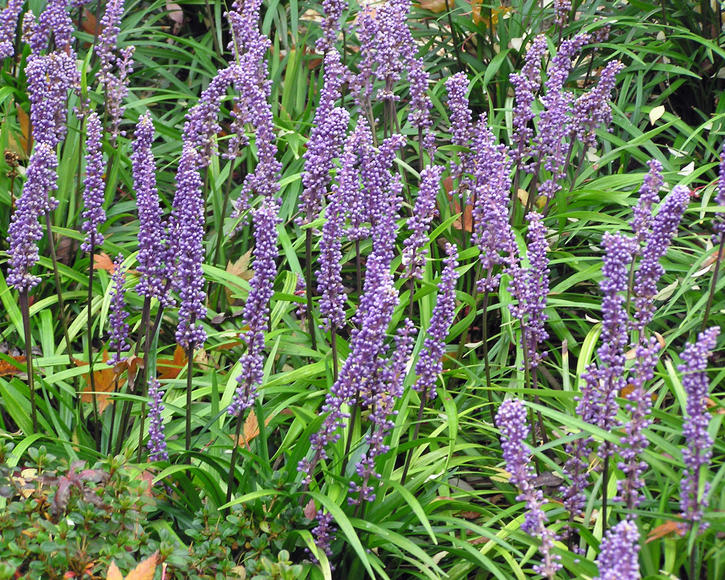Lilyturf
Lilyturf or Liriope is little known among gardeners. With its violet flower clusters, it is a precious garden rarity. Here’s how to plant and care for it.
Factsheet
- Growth type
-
- Perennial plant
- Tuber
- Growth height (from)
- from 80 cm to 100 cm
- Growth width (from)
- from 40 cm to 60 cm
- Growth characteristics
-
- cushion-forming
- horst-forming
- tight
- Flower color
-
- purple
- blue
- Flowering time (month)
-
- August to October
- Flower shape
-
- tight
- Bells
- Candle-like
- Cluster
- Leaf color
-
- green
- page format
-
- full margined
- grassy
- oblong
- lineal
- Sheet properties
-
- wintergreen
- Fruit color
-
- black
- blue
- Fruit shape
-
- Capsule
- Light
-
- semi-shade to shady
- Soil type
-
- gravelly
- loamy
- Soil Moisture
-
- fresh to humid
- ph value
-
- weakly acidic
- Lime compatibility
-
- sensitive to lime
- Nutrient requirements
-
- nutrient-rich
- Humus
-
- rich in humus
- Decorative or utility value
-
- Flower Decoration
- Winter Hardness
-
- conditionally hardy
- Climate zones according to USDA
-
- 6
- areas of life
-
- GR2
- ST2
- Use
-
- Flowerbeds
- ground cover
- Borders
- Planters
- Underplanting
- Rebates
- Garden style
-
- Flower garden
- natural garden
- Pot garden
- Forest Garden
Lilyturf (Liriope muscari), often simply called Liriope, is one of six species within the genus Liriope. It originated from Asia (China and Japan) and is assigned to the botanical family Asparagaceae.
Liriope grows as a clump-forming shrub and does not form a cushion. It is frost-hardy and wintergreen, even at our latitudes. It grows straight upright from a bulb and reaches around 3 feet tall and approx. 24 inches wide. The entire plant is slightly poisonous.
The principle characteristic of the Lilyturf is its attractive, grass like foliage bundle. It has basal, hairless, linear, full margined leaves. Its fall foliage is an attractive yellow.
Liriope shows its striking, upright flower clusters from August to October, making it a stunning fall bloomer. Its flower candles consist of numerous blue-violet bell flowers and can reach up to 16 inches long.

Lily turfs form loculicidal, dark blue-black colored capsules which contain small seeds.
The exotic, fall bloomer prefers warm, semi-shady to shady locations. Lily turf also blooms readily in sunny locations, provided its wintergreen foliage is protected with brushwood from the drying winter sun during cold spells. The location should also protect the plant from heavy wind and rain.
The Lily turf grows particularly well in humus, slightly acidic and nutrient-rich soil. Gravelly-loamy, permeable soil at least 12 inches deep is ideal. Calciferous soils should be avoided.

The best planting time for Liriope muscari is in the spring between March and April. This gives it enough time to take root before the next winter. Plants should be at a distance of approx. 10 inches from one another. when planting gives the Lily turf energy. Small groups of five to ten shrubs achieve a beautiful effect. The shrub can be sown directly in location from April. Only cover the light-germinating plant with a little soil and keep the sowing area moist.
Liriope muscari is a true rarity in gardens, although it is relatively easy-care. Keep the substrate moist but not wet. The Lily turf must be watered in particular during dry spells. Cut back the shrub by around a third in the spring. It’s best to use a garden sickle for large plants. Soon, fresh, even foliage bundles will grow back.
Large clumps can be divided every two to three years. Dig up the Liriope muscari root ball, shake off the excess soil and remove the weak roots. Separate the plant into sections using a spade. These can then be re-planted in the new location.
Lily turf is extremely versatile in the garden. Species which form off-shoots are perfect as easy-care groundcover. There are also clump-forming, beautiful flowering species and varieties, which are a real eye-catcher in the fall in multiple planted borders or as plants in smaller containers and pots. Liriope muscari can also be used advantageously as an edging plant and for planting under trees.

Liriope muscari ‘Big Blue’ is a classic among the Lily turfs. This variety grows to around 20 inches tall. ‘Moneymaker’ is a very robust, abundantly flowering variety with decorative flower clusters above compact, wintergreen tufts of greenery. With its light, striped leaves, Liriope muscari ‘Variegata’ is an extravagant collector’s piece.
Lily turf can be propagated through seeds. For this, the seed stems are harvested in the fall and placed in a bag, the seeds are released by shaking or gently beating the bag. Keep the seeds in a dry, dark place throughout the winter and sow the plants directly in the flower bed in the spring, after the last frost.
Liriope muscari sometimes suffers from anthracnose. This is a fungal disease which makes the leaves turn spotty and then die. All plant parts which are affected must be removed as quickly as possible and disposed of in the household garbage. Lily turf is not immune to root rot. In both cases a fungicide can help. The plant should be protected against snails, particularly when the leaf shoots appear in the spring.

